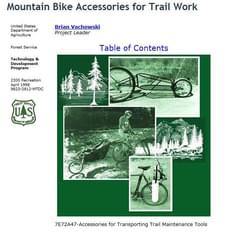




This case study shows how the Seward Ranger District on the Chugach National Forest uses mountain bikes.

Mountain bikes. You find them on nonwilderness trails everywhere. Continual improvements in bicycle suspensions, brakes, structural materials, and other key components allow mountain bikers to travel faster, farther, and with greater ease and dependability than ever before.
It should come as no surprise
that mountain bike enthusiasts who also maintain trails have seen the benefits
of using mountain bikes for trail work. This case study shows how the Seward
Ranger District on the Chugach National Forest uses mountain bikes. In
addition, it describes how the Missoula Technology and Development Center
(MTDC) worked with the District trail crew to develop a bicycle-mounted chain
saw carrier and evaluate several single-wheeled bicycle cargo trailers.
posted Sep 11, 2023
The tools shown here are those used most often by Forest Service trail crews. They are categorized into tools for sawing, chopping, grubbing, digging and tamping, pounding, and hammering, lifting and hauling, peeling and shaping, and sharpening and rehandling. Each tool is described along with helpful techniques for use and maintenance.
Tools for Trails: Measuring and Surveying Tools
posted Nov 8, 2022
Before trail builders start digging, they first have to lay the trail, flag the line, and more to ensure a grade that not only matches the terrain but also is well throughout to prevent erosion.
posted Aug 8, 2022
Let’s talk about grubbing and raking tools! You might have heard the term grubbing before, but if you’re new to trail building, it may be unfamiliar. Grubbing is when you are removing earth and topsoil. Basically digging into the first while removing vegetation in the process. Trail builders may also call this process hogging.
posted Jun 8, 2022
There are a few options for striking tools that you may see out on a project. Some like the sledge hammer will be seen more, while others may only be pulled out for special projects.
1,293 views • posted 06/11/2018